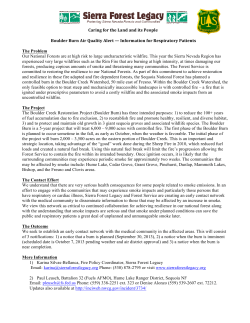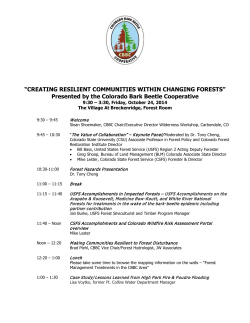
100 feet of Defensible Space Brochure
DO YOU HAVE WHAT IT TAKES? 100' of Defensible Space
For residents like you that live in areas like the Pinelands, the threat to life and property from
wildfire is a real concern. Studies show that a fast moving wildfire can destroy a home in only
ten minutes. So, take an active role in protecting your home and community from wildfire, and
reduce the threat to life and property.
Defending Your Home
Some positive physical
changes you can make to
your home include:
• Using fire-resistant roofing
and siding materials
• Enclosing spaces under
porches & decks
• Replacing mulch with
decorative stone
• Using non-resinous or less
flammable plants
• Pruning trees & shrubs to
remove dead and dying
plant life
• Reducing the density and
changing the arrangement
of landscaping
Homes require the creation of defensible space.
{
}
Understanding the Problem
Defensible Space
The area around a home or structure that is
Creating defensible space now is critical to wildfire
modified in order to protect it from damage
protection in New Jersey, more so than in the past;
by a wildfire. It is also needed to provide safe
and it is a result of explosive development, which
areas for firefighters to work.
places homes within rural landscapes. Lack of
adequate space between your home and flammable
forest vegetation, especially in areas with frequent fire
history, like the Pinelands region, could be devastating in the event of a major wildfire.
As residential communities and developments continue to spread into new, previously undisturbed
natural areas, the Wildland Urban Interface (WUI) is created. New Jersey residents that live within
the WUI, should consider the importance of creating
defensible space. The closer a home is to the trees,
Wildland Urban Interface
shrubs and other potentially flammable fuels of the
The line, area or zone where structures
forest, the more easily a wildfire can spread and impact
and other human development meet with
their
home.
undeveloped wildland or vegetative fuels.
{
}
DO YOU HAVE WHAT IT TAKES?
DO YOU HAVE WHAT IT TAKES?
To Create or Not To Create?
Residents that actively take steps to manage and maintain their property benefit directly by reducing
their risk of loss from wildfire. One of the first steps you can take is to create defensible space around
structures.
Some factors you should consider include the:
• Age and type of building materials used currently on the structure
• Plant species as well as their arrangement, health, and density
• Identification and location of flammable materials
• Location of available water sources
Communities Working Together
Many large developments use lots sized one acre or less. This is smaller than required to create adequate
defensible space. Thus, there is a shared community benefit in developing defensible space for groups of
homes, streets within developments, or entire communities.
It is also important for the community to understand the need for creating defensible space.
• Identify and create multiple evacuation routes
• Mark driveways and make them accessible to large emergency vehicles
• Clearly mark house numbers so they are visible from the street
If your neighborhood or community members can work together on their own properties, everyone will
reduce the possibility of wildfire damage. The potential for wildfire spread, evacuation, and infrastructure
damage is also reduced.
For Your Community
• Maintain forest health by monitoring for insects and disease and applying appropriate corrective
measures
• Apply measures such as prescribed
burning or mowing to reduce
understory fuels
• Create firebreaks where needed
One hundred feet is all that may be needed
to protect your home from wildfire. The
Forest Fire Service wants residents to know
that creating defensible space is critical to
protecting your home and community.
{
Fuels
}
Fuels are anything that can burn. Fuel load is a term
used to describe the amount and types of fuels
present. Ladder fuels are materials that can enable a
ground fire to climb into the tree canopy and increase
wildfire spread and intensity. Ladder fuels include; low
dead branches, dead shrubs, briars, brambles, vines,
and/or dead wood on the ground.
One hundred feet is the recommended optimum defensible space. If you don’t have 100 feet, consider
your property line your area of defensible space.
100' of Defensible Space
This Ocean County community survived a wildfire…would yours?
This Pinelands home also survived a wildfire. It has what it takes: 100' of defensible space.
Defensible Space Checklist
GENERAL
Ensure house numbers/driveways are visible
from the roadway
Your property’s driveway must be 16 feet wide
to allow emergency vehicle access
Use fire-resistant roofing and siding when
building or remodeling
☑
Maintain healthy plants by watering and
pruning out dead wood
Use non-resinous, well-watered landscape
plants (No evergreens/laurel/rhododendrons)
LANDSCAPING
Mow & water lawns
Enclose the underside of decks, porches, and
foundations
Keep grasses to a maximum of six to eight
inches in height
Clean gutters & roof surfaces of leaves/debris
in the spring and fall
Choose stone instead of wood mulch
Inspect chimney/fireplace flue
Remove tree branches/dead limbs within
10 feet of chimney/house
Develop a water supply (100' garden hose on
exterior outlet)
Remove all dead wood in trees and low
hanging branches
Keep a shovel, rake, and hose readily available
and in good condition
Prune large shrubs and trees so there are at
least 10 feet between their crowns/canopies
Stack firewood 30 feet away from house
Remove ladder fuels, such as low branches,
vines, and shrubs from contact with larger trees
Have an approved spark arrestor/heavy wire
screen on fireplace
Screen/cover openings in roof, attics, and floors
Keep flammables in safety cans
AND ALWAYS REMEMBER TO…
Plan alternate escape routes if an evacuation is
necessary
PLANTS
Designate a safe location where your family
may gather
Space plants to minimize contact with
structures and each other
Remove dead plants and prune out all dead
material from living plants
Report any suspicious activity or suspected
arson by calling 911 or your local Forest
Firewarden
For More Information Contact:
Northern New Jersey
Division A Headquarters
NJ Forest Fire Service
240 Main Street
Andover, NJ 07821
(973) 786–6350
Central New Jersey
Division B Headquarters
NJ Forest Fire Service
P.O. Box 239
New Lisbon, NJ 08064
(609) 726–9010
Southern New Jersey
Division C Headquarters
NJ Forest Fire Service
5555 Atlantic Ave
Mays Landing, NJ 08330
(609) 625–1121
State Headquarters
NJ Forest Fire Service
P.O. Box 404
501 East State Street
Trenton, NJ 06825
(609) 292–2977
www.njwildfire.org
© Copyright 2025


















